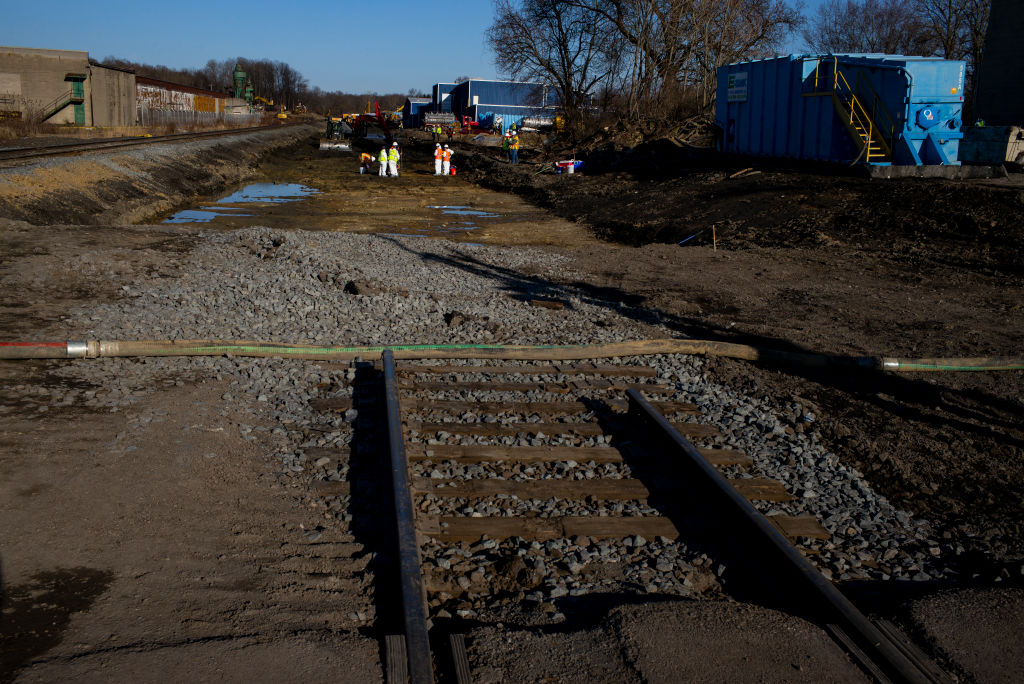It was all over in a manner of hours. The National Transportation Safety Board (NTSB) spent two days in East Palestine, OH, to determine what happened at the site of the toxic derailment of Norfolk Southern Railway freight train 32N. Technical and chemical experts, railroad engineers, first responders, and the yardmaster all paraded one by one to testify, some tattling, some claiming it was all in a day’s business and that derailments happen.
Armed with first-person accounts and 278 official exhibits equating to around 5,000 pages of information from all parties involved, the NTSB is off to write an official report. “It is our hope that this Hearing and our subsequent investigation report will yield recommendations which, once acted upon, will prevent future derailments and hazmat releases from harming communities like East Palestine and its neighbors,” concluded NTBS Hearing Chair, the honorable Jennifer Homendy.
What did they accomplish? Well, Norfolk Southern (NS) was told to get busy being compliant and not wait for an official report to implement enhanced safety measures.
What Was Uncovered?
Transcripts of witness testimony tell a tale of miscommunication, ignored warnings, faulty equipment, and a lack of clear decision making. One NS engineer had expressed concerns about how the toxic tanks were positioned: “If you talk to the manager, they said this train was 100 percent rule compliant,” adding, “To me, in my opinion, you got 32 percent of the weight on the headend, twenty percent in the middle, and 40 percent weight on the rear end.” He also reported this to the yardmaster, who told him, “This is what they [NS] want.”
 The train was sparking 40 minutes outside of East Palestine. Resident and business cameras showed flames under one of the 149 railcars traveling past. Yet conductor Kevin Stauffer relayed to investigators that it “was minutes” after the heat sensor alarm signaled a critical issue. “There’s an instinct when you see a fire. You know, a big fire back there, and I was like, ‘Yeah, we’ve got to get out of here.’” Stauffer climbed out and was uninjured.
The train was sparking 40 minutes outside of East Palestine. Resident and business cameras showed flames under one of the 149 railcars traveling past. Yet conductor Kevin Stauffer relayed to investigators that it “was minutes” after the heat sensor alarm signaled a critical issue. “There’s an instinct when you see a fire. You know, a big fire back there, and I was like, ‘Yeah, we’ve got to get out of here.’” Stauffer climbed out and was uninjured.
A chilling discovery through testimony was the lack of communication by NS to local first responders. The train derailed in a rural area of Ohio, and the fire department there consisted of volunteers. These firefighters have approximately 36 hours of training compared to a municipal department that requires 200 hours – including hazmat conditions, substances, and responses. East Palestine Fire Chief Keith Drabick testified that they were on scene at least 15 minutes before any communications from NS about what toxic chemicals were in the tanks. The railway then gave Drabick 13 minutes to make a call about venting the cars and allowing them to burn and release toxic fumes into the environment.
“All data, resources, and all of our combined experiences had us with a legitimate concern for polymerization and lack of tactical options except vent and burn, which is a known, proven tactical option,” said Drew McCarty, president of Specialized Professional Services – the contractor hired to consult and clean up the mess.

(Photo by Michael Swensen/Getty Images)
But Steve Smith, a technical manager for OxyVinyls, the manufacturer of the vinyl chloride, had spoken to McCarty and did not share with him or NS that the chemical would not cause an explosion and that the burn would not be necessary. He dodged and said, “It really wasn’t my role.”
“The final yes was given by me based on the consensus of everybody in the unified command that there was no other option,” explained Chief Drabick.
East Palestine Derailment Takeaways
Americans may not know that the Association of American Railroads has a common carrier obligation, and all must haul a certain amount of hazardous materials. Group H Exhibit 36 describes:
“Railroads are just one step in the production, distribution, and consumption chain for hazmat. Even though the transportation of hazmat involves actions and decisions by many parties, railroads bear most of the risks of an accident or incident during transportation.”
In no uncertain terms, the derailment, the release of toxins, the evacuation of 2,500 residents, and the unknown future health issues from the smoke that billowed across the fresh winter air in the countryside of Ohio will fall squarely at the feet of Norfolk Southern.
Alan Shaw, chief executive railway, said on the record: “As soon as that thing happened, that terrible accident, I said we are going to do more than less. That means more assistance. That means more of my personal involvement than less.”
All opinions expressed are those of the author and do not necessarily represent those of Liberty Nation.
Do you have an opinion about this article? We’d love to hear it! If you send your comments to [email protected], we might even publish your edited remarks in our new feature, LN Readers Speak Out. Remember to include the title of the article along with your name, city, and state.
Please respect our republishing guidelines. Republication permission does not equal site endorsement. Click here

